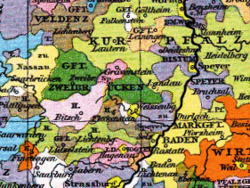County of Nassau-Saarbrücken
| County of Nassau-Saarbrücken | ||||||||||
| Grafschaft Nassau-Saarbrücken (de) | ||||||||||
| State of the Holy Roman Empire | ||||||||||
|
||||||||||
|
County of Nassau-Saarbrücken (beige, l.), about 1400
|
||||||||||
| Capital | Saarbrücken | |||||||||
| Government | Principality | |||||||||
| Historical era |
Middle Ages Early modern period |
|||||||||
| • | Inherited by Nassau-Weilburg |
1381 | ||||||||
| • | Joined Upper Rhenish Circle |
1500 | ||||||||
| • | Held in personal union by Nassau-Weilburg |
1574-1627 | ||||||||
| • | Inherited by Nassau-Usingen |
1728 | ||||||||
| • | Annexed by France | 1797 | ||||||||
|
||||||||||
The County of Saarbrücken was an Imperial State in the Upper Lorraine region, with its capital at Saarbrücken. From 1381 it belonged to the Walram branch of the Rhenish House of Nassau.
Around the year 1080 King Henry IV of Germany vested one Count Siegbert in the Saargau with the Carolingian Kaiserpfalz at Wadgassen on the Saar River and further possessions held by the Bishops of Metz in the Bliesgau as well as in the adjacent Alsace and Palatinate regions as a fiefdom.
In the course of the fierce Investiture Controversy, the rise of the comital dynasty continued with the appointment of Siegbert's son Adalbert as Archbishop of Mainz in 1111, and in 1118 his elder brother Frederick was first mentioned with the title of a "Count of Saarbrücken". However, Frederick's son Simon I had to face the slighting of his Saarbrücken residence by the forces of Emperor Frederick Barbarossa in 1168. Upon his death about 1183, the county was divided into two parts, when the Palatinate territories were separated to form the basis of the County of Zweibrücken. The Alsatian possessions had been lost already around 1120.
...
Wikipedia


